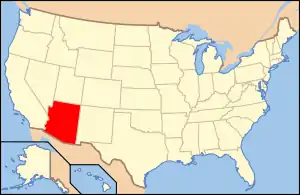Grand Canyon Railway
The Grand Canyon Railway (reporting mark GCRX), is a heritage railroad which carries passengers between Williams, Arizona and the South Rim of Grand Canyon National Park.
| Grand Canyon Railway | ||||||||||||||||||||||||||||||||||||||||||||||||||||||||||||||||||||||||||||||||||||||||||||||||||||||||||||||||||||||||||||||||||||||||||||||||||||||||||||||||||||
|---|---|---|---|---|---|---|---|---|---|---|---|---|---|---|---|---|---|---|---|---|---|---|---|---|---|---|---|---|---|---|---|---|---|---|---|---|---|---|---|---|---|---|---|---|---|---|---|---|---|---|---|---|---|---|---|---|---|---|---|---|---|---|---|---|---|---|---|---|---|---|---|---|---|---|---|---|---|---|---|---|---|---|---|---|---|---|---|---|---|---|---|---|---|---|---|---|---|---|---|---|---|---|---|---|---|---|---|---|---|---|---|---|---|---|---|---|---|---|---|---|---|---|---|---|---|---|---|---|---|---|---|---|---|---|---|---|---|---|---|---|---|---|---|---|---|---|---|---|---|---|---|---|---|---|---|---|---|---|---|---|---|---|---|---|
 | ||||||||||||||||||||||||||||||||||||||||||||||||||||||||||||||||||||||||||||||||||||||||||||||||||||||||||||||||||||||||||||||||||||||||||||||||||||||||||||||||||||
 Ex-Chicago Burlington and Quincy 4960 on the Grand Canyon Railway | ||||||||||||||||||||||||||||||||||||||||||||||||||||||||||||||||||||||||||||||||||||||||||||||||||||||||||||||||||||||||||||||||||||||||||||||||||||||||||||||||||||
| Locale | Coconino County, Arizona, US | |||||||||||||||||||||||||||||||||||||||||||||||||||||||||||||||||||||||||||||||||||||||||||||||||||||||||||||||||||||||||||||||||||||||||||||||||||||||||||||||||||
| Terminus | Grand Canyon Village | |||||||||||||||||||||||||||||||||||||||||||||||||||||||||||||||||||||||||||||||||||||||||||||||||||||||||||||||||||||||||||||||||||||||||||||||||||||||||||||||||||
| Commercial operations | ||||||||||||||||||||||||||||||||||||||||||||||||||||||||||||||||||||||||||||||||||||||||||||||||||||||||||||||||||||||||||||||||||||||||||||||||||||||||||||||||||||
| Built by | Atchison, Topeka and Santa Fe Railway | |||||||||||||||||||||||||||||||||||||||||||||||||||||||||||||||||||||||||||||||||||||||||||||||||||||||||||||||||||||||||||||||||||||||||||||||||||||||||||||||||||
| Original gauge | 4 ft 8 1⁄2 in (1,435 mm) standard gauge | |||||||||||||||||||||||||||||||||||||||||||||||||||||||||||||||||||||||||||||||||||||||||||||||||||||||||||||||||||||||||||||||||||||||||||||||||||||||||||||||||||
| Preserved operations | ||||||||||||||||||||||||||||||||||||||||||||||||||||||||||||||||||||||||||||||||||||||||||||||||||||||||||||||||||||||||||||||||||||||||||||||||||||||||||||||||||||
| Owned by | Xanterra Parks and Resorts | |||||||||||||||||||||||||||||||||||||||||||||||||||||||||||||||||||||||||||||||||||||||||||||||||||||||||||||||||||||||||||||||||||||||||||||||||||||||||||||||||||
| Operated by | Grand Canyon Railway | |||||||||||||||||||||||||||||||||||||||||||||||||||||||||||||||||||||||||||||||||||||||||||||||||||||||||||||||||||||||||||||||||||||||||||||||||||||||||||||||||||
| Reporting mark | GCRY | |||||||||||||||||||||||||||||||||||||||||||||||||||||||||||||||||||||||||||||||||||||||||||||||||||||||||||||||||||||||||||||||||||||||||||||||||||||||||||||||||||
| Length | 64 mi (103 km) | |||||||||||||||||||||||||||||||||||||||||||||||||||||||||||||||||||||||||||||||||||||||||||||||||||||||||||||||||||||||||||||||||||||||||||||||||||||||||||||||||||
| Preserved gauge | 4 ft 8 1⁄2 in (1,435 mm) standard gauge | |||||||||||||||||||||||||||||||||||||||||||||||||||||||||||||||||||||||||||||||||||||||||||||||||||||||||||||||||||||||||||||||||||||||||||||||||||||||||||||||||||
| Commercial history | ||||||||||||||||||||||||||||||||||||||||||||||||||||||||||||||||||||||||||||||||||||||||||||||||||||||||||||||||||||||||||||||||||||||||||||||||||||||||||||||||||||
| Opened | 1901 | |||||||||||||||||||||||||||||||||||||||||||||||||||||||||||||||||||||||||||||||||||||||||||||||||||||||||||||||||||||||||||||||||||||||||||||||||||||||||||||||||||
| Closed to passengers | 1968 | |||||||||||||||||||||||||||||||||||||||||||||||||||||||||||||||||||||||||||||||||||||||||||||||||||||||||||||||||||||||||||||||||||||||||||||||||||||||||||||||||||
| Closed | 1974 | |||||||||||||||||||||||||||||||||||||||||||||||||||||||||||||||||||||||||||||||||||||||||||||||||||||||||||||||||||||||||||||||||||||||||||||||||||||||||||||||||||
| Preservation history | ||||||||||||||||||||||||||||||||||||||||||||||||||||||||||||||||||||||||||||||||||||||||||||||||||||||||||||||||||||||||||||||||||||||||||||||||||||||||||||||||||||
| 1988 | Max and Thelma Biegert Ownership | |||||||||||||||||||||||||||||||||||||||||||||||||||||||||||||||||||||||||||||||||||||||||||||||||||||||||||||||||||||||||||||||||||||||||||||||||||||||||||||||||||
| 1989 | reopened | |||||||||||||||||||||||||||||||||||||||||||||||||||||||||||||||||||||||||||||||||||||||||||||||||||||||||||||||||||||||||||||||||||||||||||||||||||||||||||||||||||
| 2006 | Xanterra ownership | |||||||||||||||||||||||||||||||||||||||||||||||||||||||||||||||||||||||||||||||||||||||||||||||||||||||||||||||||||||||||||||||||||||||||||||||||||||||||||||||||||
| Headquarters | Williams | |||||||||||||||||||||||||||||||||||||||||||||||||||||||||||||||||||||||||||||||||||||||||||||||||||||||||||||||||||||||||||||||||||||||||||||||||||||||||||||||||||
| Website | ||||||||||||||||||||||||||||||||||||||||||||||||||||||||||||||||||||||||||||||||||||||||||||||||||||||||||||||||||||||||||||||||||||||||||||||||||||||||||||||||||||
| www | ||||||||||||||||||||||||||||||||||||||||||||||||||||||||||||||||||||||||||||||||||||||||||||||||||||||||||||||||||||||||||||||||||||||||||||||||||||||||||||||||||||
| ||||||||||||||||||||||||||||||||||||||||||||||||||||||||||||||||||||||||||||||||||||||||||||||||||||||||||||||||||||||||||||||||||||||||||||||||||||||||||||||||||||
The 64-mile (103-kilometer) railroad, built by the Atchison, Topeka and Santa Fe Railway, was completed on September 17, 1901. The arrival of trains led increased tourism to the area, and the railway company was instrumental in the creation of the Grand Canyon Village to serve guests. Declining ridership due to the popularity of the automobile led the Atchison, Topeka and Santa Fe Railway to cease passenger service of the Grand Canyon Railway in July 1968 and freight service on the line ended in 1974.
Private investors purchased the line in 1988, restored the facilities, and started running passenger trains again on September 17, 1989. Today, the railroad carries hundreds of passengers to and from the canyon every day and operates year-round.
The entire Grand Canyon Railway has been added to the National Register of Historic Places, recognizing the contribution the train has made to the history of the United States.
History
Santa Fe Ownership
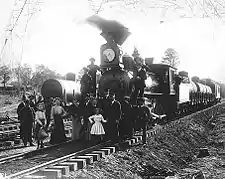
In 1901, the Atchison, Topeka and Santa Fe Railway completed a branch line from Williams to Grand Canyon Village at the South Rim. The first scheduled train to carry paying passengers of the Grand Canyon Railway arrived from Williams on September 17 of that year. The 64-mile (103-kilometer) long trip cost $3.95, and naturalist John Muir later commended the railroad for its limited environmental impact. To accommodate travelers, the Santa Fe designed and built the El Tovar Hotel, located just 20 feet (6.1 meters) from the Canyon Rim. El Tovar opened its doors in January 1905
Competition with the automobile forced the Santa Fe to cease operation of the Grand Canyon Railway in July 1968 (only three passengers were on the last run), although Santa Fe continued to use the tracks for freight until 1974.
Plans by entertainer Arthur Godfrey to resume service in 1977 fell through. In addition, two other companies attempted to resurrect the line in 1980 and 1984, with each attempt helping to maintain interest in preserving the line and saving it from scrapping.
Max and Thelma Biegert ownership
In 1988, the line was bought by Max and Thelma Biegert, a couple from Phoenix, Arizona. The railway was restored and in 1989 began operations as a separate company, independent of the Santa Fe. The first run of the restored railroad was on September 17, 1989, commemorating the September 17 debut of the original railroad.[1]

The Biegerts, a couple originally from Nebraska, had made their fortune in crop dusting through Biegert Aviation, founded in 1947, which had a large federal government contract for its B-17 and later C-54 fleet.[2] After leaving the crop-dusting business, they operated a for-profit day care business in Houston, Texas, which became the Children's World Learning Center and is now part of KinderCare Learning Centers. The Biegerts never intended to get into the rail business. They had loaned money secured by the tracks to another person for the rail line. When they defaulted the Biegerts took over the line.[3] In conjunction with the startup, the Biegerts were principal investors in the short-lived Farwest Airlines, an air taxi service operating a DHC Dash 7[4] that was intended to bring tourists from California, Las Vegas and Phoenix to Flagstaff where the passengers would then take the rail line.[5]
The first locomotives the railway acquired were a pair of emd gp7u units from the Santa Fe, as well as four 2-8-0 consolidation steam locomotives formerly operated by the Lake Superior and Ishpeming Railroad. In the early 1990s, the Grand Canyon Railway purchased a fleet of 1950s-era ALCO FA Diesel-electric locomotives, featuring an iconic "snub nose" design. The fleet consisted of two cab-equipped lead A unit models and two cabless booster B unit models. The new locomotives supplemented the fleet of steam locomotives and allowed the railway to grow into a year-round operation. In 1996, the railway boosted their steam roster by restoring a 2-8-2 mikado; former Chicago Burlington and Quincy 4960, a locomotive with a long history of excursion service.
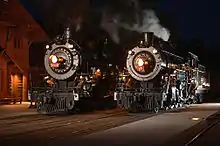
The ALCO FA locomotives lacked the features found in more modern units, such as increased horsepower and dynamic brakes. Therefore, in February 2003, the Grand Canyon Railway purchased three late-1970s F40PH locomotives from Amtrak and placed them into service in 2004.
In March 2006, owners Max and Thelma Biegert announced to the media that they were placing the railroad and its associated restaurants, hotels and amenities up for sale. The combined properties had an annual revenue of nearly $40 million. The Biegerts sought a new buyer/operator with a possible theme park background, which would ensure that the railroad, hotels, RV park, restaurants (and a possible new amusement park in Williams) would continue to be operated as one entity.
Xanterra ownership
On September 21, 2006, it was announced that Xanterra Parks & Resorts of Denver, Colorado, submitted the winning bid (for an undisclosed sum) and was selected as the new owner for the Grand Canyon Railway. Xanterra is the corporate name and identity for what was originally known as the Fred Harvey Company, a company with restaurant, hotel and service ties to the Atchison, Topeka & Santa Fe Railway as far back as 1876.
Xanterra said that it intended to keep all 480 of the railway's current employees, and planned to focus on growing the business and increasing the coordination between the railway and Xanterra's other services in the Grand Canyon National Park's South Rim. In the press release, the railway and Xanterra reported over 225,000 passengers and over $38 million in revenue in calendar year 2005. The purchase of the GCR included all of the railway's assets, depots, hotels, RV park, rolling stock, shops and the land on which the 65-mile (105 km) line operates over.
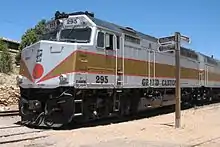
Steam locomotive operations on the Grand Canyon Railway were suspended in September 2008. Xanterra cited extra diesel fuel costs and environmental concerns as the reason for the decision, pointing out that each roundtrip of a steam locomotive consumed 1,450 gallons of diesel fuel (compared to the 550 gallons used by a diesel-electric locomotive) and 1,200 gallons of water. Industry experts said that ridership losses due to the late 2000s recession and rising fuel prices due to the 2000s energy crisis likely contributed to the decision.[6][7]
Steam locomotives would return to the Grand Canyon Railway on September 19, 2009. Xanterra converted the steam locomotives to operate using waste vegetable oil collected from restaurants across Northern Arizona and installed a rainwater collection system on the maintenance building to fill boilers when available. Since 2011, special occasion trips, and at least one roundtrip per month during the summer is operated using a steam locomotive. In 2017, the Grand Canyon Railway added to its fleet of diesel locomotives, purchasing two additional F40PH units from New Jersey Transit. As of 2021, the Grand Canyon Railway only has two steam locomotives left in their roster. In 2019, the GCR purchased three Ex-Rio Grande business cars,[8] and since then, the GCR used them exclusively for private charter service, with the option of being pulled by steam or diesel.
Locomotive roster
| Number | Builder | Date | Type | Former railroad | Status | Notes |
|---|---|---|---|---|---|---|
| 5 | Lima | May 1923 | Steam Shay | Anaconda Copper Mining Co. | Static display | Never operated in Arizona, but was acquired by the Arizona State Railroad Museum to represent the shays used by various logging and short line railroads in Northern Arizona. Displayed by the Grand Canyon Hotel since 2014.[10] |
| 29 | Alco | May 1906 | Steam SC-3 2-8-0 | Lake Superior and Ishpeming | Stored | No. 29 was originally numbered 14 on the LS&I. Rebuilt after a wreck in 1916, and heavily rebuilt again in 1925 and was numbered 29 ever since. It has been operating on the GCR since April 1990. It has heavily modified since then. It can pull up to nine loaded passenger cars. It is now awaiting a mandated 1,472 day boiler inspection required by the Federal Railroad Administration. |
| 4960 | Baldwin | August 1923 | Steam O-1a 2-8-2 | Chicago Burlington and Quincy | Operational. | No. 4960 has had a history of excursion service. It operated for the CB&Q steam program between 1958 and 1966, it operated for the Bristol and North Western between 1981 and 1984, and it has operated for GCR since June 1996 after being rebuilt with multiple modifications, including a larger tender, a smaller smokebox, a lempor exhaust system, and a Worthington feedwater heater. It can pull up to twelve loaded passenger cars at a top speed of 65 mph, but the speed limit on GCR is 40 mph. |
| 1105 | EMD | 1952 | Diesel gp7u | Atchison Topeka and Santa Fe | Operational | Used primarily for moving equipment around the Williams Locomotive Yard, No. 1105 can also be seen pulling the annual Pumpkin Patch Train every October. |
| 2134 | EMD | 1953 | Diesel gp7u | Atchison Topeka and Santa Fe | Stored | Out of service since 2009 |
| 6762 | Alco | 1958 | Diesel FPA-4 | Canadian National, Via Rail | Stored | Never operated on the GCR. Spare parts provider for the other diesel units. Still in Via colors. |
| 6768 | Alco | 1959 | Diesel FPA-4 | Canadian National, Via Rail | Stored | Never operated on the GCR. Spare parts provider for the other diesel units. Still in Via colors. |
| 6773 | Alco | 1959 | Diesel PFA-4 | Canadian National, Via Rail | Stored | Out of service since 2009. |
| 6776 | Alco | 1959 | Diesel PFA-4 | Canadian National, Via Rail | Static display | Out of service since 2009. Repainted into GCR gold and silver for static display at the Grand Canyon Village since 2016. |
| 6793 | Alco | 1959 | Diesel PFA-4 | Canadian National, Via Rail | Operational | Limited for use pulling the Williams Flyer. |
| 6860 | Alco | 1958 | Diesel PFB-4 | Canadian National, Via Rail | Operational | Limited for use pulling the Williams Flyer. |
| 6871 | Alco | 1959 | Diesel PFB-4 | Canadian National, Via Rail | Stored | Out of service since 2009. |
| 237 | EMD | 1977 | Diesel F40FH | Amtrak | Operational | Operating for the GCR since 2010. |
| 239 | EMD | 1977 | Diesel F40FH | Amtrak | Operational | Operating for the GCR since 2004. |
| 295 | EMD | 1979 | Diesel F40FH | Amtrak | Operational | Operating for the GCR since 2009. |
| 4124 | EMD | 1981 | Diesel F40FH | NJ Transit | Operational | Operating for the GCR since 2017. |
| 4128 | EMD | 1981 | Diesel F40FH | NJ Transit | Operational | Operating for the GCR since 2017. |
| Number | Builder | Date | Type | Former railroad | Status | Notes |
|---|---|---|---|---|---|---|
| 18 | Alco | January 1910 | Steam SC-4 2-8-0 | Lake Superior and Ishpeming | Stored, put up for sale/lease. | It was the first steam locomotive to be restored on GCR in 1989, albeit in 27 days. With the increasing weight of the trains on the GCR, the 18 was put on display at the Williams Depot in 2003. In 2007, it was traded to Iowa Pacific Holdings in exchange for 2-8-2 539, and it operated on the Mount Hood Railroad right before being transferred to the Rio Grande Scenic to operate until 2013. As of 2021, it is put up for sale at Alamosa, Colorado.[11] |
| 19 | Alco | January 1910 | Steam SC-4 2-8-0 | Lake Superior and Ishpeming | Static display | Never operated on the GCR. It was put on static display at Williams, until being sold to MGM Grand Adventures Theme Park[12] in 1993. In 2004, it was sold to the city of Frisco, Texas for static display in Frisco livery. It still remains there today. |
| 20 | Alco | January 1910 | Steam SC-4 2-8-0 | Lake Superior and Ishpeming | Static display | Never operated on the GCR. It was put on static display at Williams, until being sold along with No. 18 to Iowa Pacific Holdings in 2007. In October 2020, it was sold to the city of Allen, Texas for static display in Frisco livery.[13] |
| 539 | Alco | 1917 | Steam O-3 2-8-2 | Northern Pacific, Spokane Portland and Seattle | Static display | It was on static display in Battle Ground, Washington for a restoration that never happened. In 2007, it was traded to GCR in exchange for Nos 18 and 20. The GCR had plans to restore the locomotive, but such plans never came to full fruition. It was moved to Williams depot and received a cosmetic repaint to improve its overall looks as a static display. In 2019, it was purchased by the Port of Kalama, who has the hopes of putting the locomotive on static display indoors.[14] |
Operations

The railroad carries hundreds of passengers to and from the canyon every day, totaling about 225,000 people per year.[15]
The restored Santa Fe Railway Station in Williams serves as the southern terminus for the Grand Canyon Railway and the Grand Canyon Depot, owned by the National Park Service, is the northern terminus for passengers of the line.
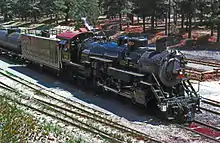
Most trains are pulled by the Railway's fleet of F40PH diesel locomotives. They were regeared to run at freight locomotive speeds and have been redesignated as F40FH. Steam locomotives pull trains on special holidays and the first Saturday of the peak travel season (March through October). The Grand Canyon Railway's fleet of historic ALCO FA diesel locomotives also see occasional use.
Passengers ride to and from the Grand Canyon in 1950s era climate-controlled coaches. During the peak travel season, 1920s era Pullman Harriman style coaches with open windows are also available.
The railroad adds to the Old West experience by having actors dressed as bandits stage a mock train robbery during the return trip from the Grand Canyon to Williams.
The Grand Canyon Railway offers at least one daily round trip of its Williams Flyer train between Williams and the Grand Canyon every day except on Christmas Day, December 25. During peak demand periods a second train departure is added.[16]
| Station | Time |
|---|---|
| Leave Williams | 9:30 am |
| Arrive Grand Canyon | 11:45 am |
(time at Grand Canyon) | |
| Leave Grand Canyon | 3:30 pm |
| Arrive Williams | 5:45 pm |
| Station | Time |
|---|---|
| Leave Williams | 10:30 am |
| Arrive Grand Canyon | 12:45 pm |
(time at Grand Canyon) | |
| Leave Grand Canyon | 4:30 pm |
| Arrive Williams | 6:45 pm |
During the winter season (November – January), the line runs The Polar Express from Williams to the 'North Pole', a station about 17 miles (30 km) north of town. In 2008, this winter service carried about 78,000 passengers.
The route included stops at Quivero, Valle, Willaha, and Coconino stations.
Grand Canyon Railway | |
 Williams Depot | |
| Nearest city | Williams, Arizona |
|---|---|
| Area | 1,682 acres (681 ha) |
| Built | 1898 |
| Architect | Santa Fe & Grand Canyon RR; Atchison, Topeka & Santa Fe RR |
| Architectural style | Classical Revival |
| NRHP reference No. | 00000319[17] |
| Added to NRHP | August 23, 2000 |
Historic designations

The entire Grand Canyon Railway has been added to the National Register of Historic Places for being associated with events that made a significant contribution to the broad patterns of the history of the United States. In the nomination to the register, the railroad was credited with, "Opening up of a large area north of Williams, the building of the Grand Canyon National Park facilities at the south rim, establishment of a solid tourist trade in the American Southwest, support of cattle and sheep ranching, copper and uranium mining, lumber industries, and the building of a sub culture around the railroad that continues to this day."[18]
The Grand Canyon Depot was added to the register on September 6, 1974, while the Williams Depot and the rest of the railroad between Williams and the Grand Canyon National Park was added as a Historic District on August 23, 2000. The Grand Canyon Depot was also designated as a National Historic Landmark on May 28, 1987 for its outstanding historical significance.[19]
See also
![]() National Register of Historic Places portal
National Register of Historic Places portal
![]() Trains portal
Trains portal
References
- "Grand Canyon Railway history". Archived from the original on 2009-02-25. Retrieved 2007-03-26.
- "Archived copy". Archived from the original on 2008-06-05. Retrieved 2008-09-13.CS1 maint: archived copy as title (link)
- "Archived copy". Archived from the original on 2011-06-12. Retrieved 2008-09-13.CS1 maint: archived copy as title (link)
- "Farwest Airlines". Airline History. Retrieved 3 May 2020.
- "Planes, Trains and the Grand Canyon – plus masked men and marshals on horseback". Retrieved 1 March 2017.
- "Ridership loss, rising fuel prices drove GCR to cancel steam program". Trains. 2008-09-11. Retrieved 2008-09-14.
- "Top 10 railroad stories of 2008". Trains News Wire. 2008-12-31. Retrieved 2009-01-07.
- Alex; June 19, er D. Mitchell IV |; 2019. "Former Rio Grande business cars find a haven at Grand Canyon | Trains Magazine". TrainsMag.com. Retrieved 2021-01-22.CS1 maint: numeric names: authors list (link)
- "Train Equipment | Grand Canyon Railway & Hotel". Grand Canyon Railway. Retrieved November 16, 2018.
Our primary movers are 3 EMD F-40PH Diesel locomotives, acquired in February 2003. General Motors Electro Motive Division built Nos. 237 and 239 in 1977 and No. 295 in 1979. Amtrak used the engines through the late 1990s. These engines have been fully refurbished and modernized, and have been in service with GCR since 2004.
- "Arizona State Railroad Museum collection expands with 1970s era replica". Williams News. Retrieved 2021-01-22.
- "Lake Superior & Ishpeming Railroad 2-8-0 #18 – Ozark Mountain Railcar". Retrieved 2020-11-28.
- GmbH, Emporis. "Exhibition of a steam engine in an open mini theme park during the 1990's, MGM Grand Resort & Casino, Las Vegas | Image 322651". www.emporis.com. Retrieved 2020-12-05.
- "RailPictures.Net Photo: LS&I 20 Lake Superior & Ishpeming Steam 2-8-0 at Allen, Texas by Nelson Acosta Spotterimages". www.railpictures.net. Retrieved 2020-12-11.
- Fairbanks, Katie. "Vintage steam locomotive installed in Port of Kalama's museum". Longview Daily News. Retrieved 2020-11-28.
- "Backgrounder | Grand Canyon Railway & Hotel". thetrain.com. Retrieved 2018-11-06.
- "Daily Train Schedule | Grand Canyon Railway". Grand Canyon Railway. Retrieved November 1, 2018.
- "National Register Information System". National Register of Historic Places. National Park Service. July 9, 2010.
- "Grand Canyon Railway - National Register of Historic Places". National Park Service. August 23, 2000. Retrieved November 6, 2017.
- "Grand Canyon Depot". National Historic Landmark summary listing. National Park Service. Archived from the original on 2009-03-04. Retrieved 2007-09-27.
External links
- Grand Canyon Railway official website
- History of Line
- More History of Line
| Wikimedia Commons has media related to Grand Canyon Railway. |

